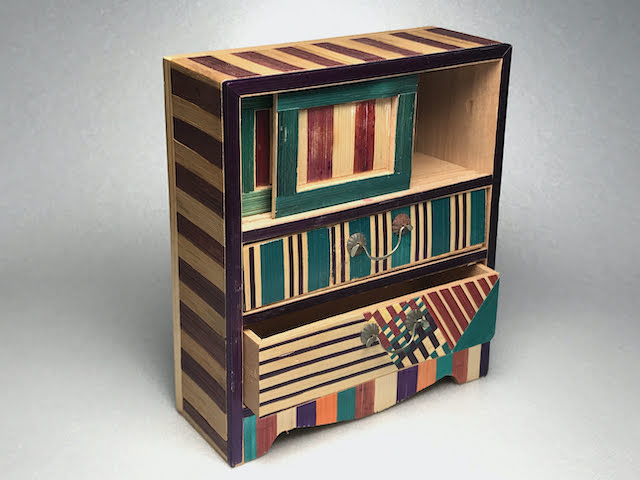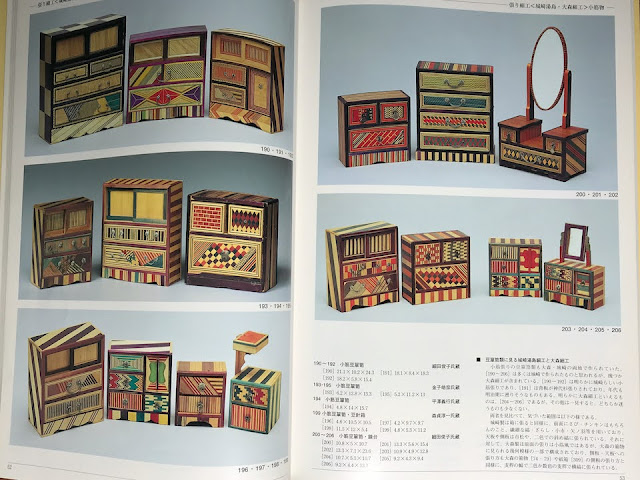麦わら細工 Straw Marquetry
左のたんすは幅 10.5 cm、高さ 12.5cm、右の鏡台は幅 9 cm、高さ 15 cm。
Chest of drawers: width = 10.5 cm, height = 12.5 cm. Mirror: width = 9 cm, height = 15 cm.
ひな祭りの道具か子供のままごと道具か用途はよくわからないが、なかなかよくできたミニチュアの家具である。これらは「麦わら細工」とよばれ、刈り取り後の麦の茎(麦わら、麦稈)を乾燥、染色して平らにのして器物に貼りつけたもの。麦わらは頑丈で光沢があるので、まるで漆を重ね塗りしたかのような効果が得られる。
These are miniature furnitures decorated with straw marquetry (a technique covering a material with dried, colored, and flattened straws), probably used as child's toys or as decoration in Hinamatsuri (March 3rd, Girl's Festival). As straws are firm and lustrous, straw marquetry looks like a lacquer (urushi) ware.
The drawer has a metal handle. The mirror's handle is a dummy, but there is a secret slit from which any small item can be stored.
日本の麦わら細工については大田区立郷土博物館編「麦わら細工の輝き」(1999)がくわしい。麦わらを編んで簡単な人形をつくるような遊びは昔から子どもたちのあいだでおこなわれていたが、もっと精緻な手工芸品としては兵庫県の城崎温泉と東京都大田区の大森とが二大産地になる。ともに江戸時代より土産物として人気を博したようだ。大森の麦わら細工は昭和初期に廃れたが、城崎の麦わら細工はいまも作られている。現在日本で麦わら細工というとここで示したような「張り細工」がよく知られるが、大森では麦わらを編み込んで動物とか玩具を形どった「編み細工」も作られた。大森細工は編み方があまりに複雑でその技術はながらく途絶えていたが、近年復活させる試みがなされている。麦わらは色とりどりに染められて、さらに昔の作品には古色がついて、たいへん趣深い。なんとなく東欧やロシアの民芸品に通ずる色づかいのようにおもえる。
Japanese straw crafts are reviewed in a book, Mugiwara-zaiku no Kagayaki (Brilliance of Straw Crafts; Ota Local Museum, Tokyo, 1999). They have mainly been produced in Omori, Ota-Ku, Tokyo, and Kinosaki, Hyogo prefecture, since the Edo period. Omori's straw crafts are no longer made since the early 20th century, but Kinosaki is still active. In Omori, animal dolls and toys woven from straws were also made as well as marquetry. I think the colors of Japanese straw crafts resemble those of crafts in Eastern Europe or Russia.
From a book, Mugiwara-zaiku no Kagayaki. Most of these small furnitures were made in Kinosaki in the early 20th century, but some of them in Omori.
参考
-
城崎麦わら細工伝承館(地図)。城崎温泉のお土産屋では麦わら細工のコースターとかキーホルダーとか売っている。
Kinosaki Straw Works Museum (Map). You can buy some straw crafts at Kinosaki Onsen souvenir shops.
-
大田区立郷土博物館(地図)。麦わら細工の講習会を開催しているようだ。
Ota Local Museum (Map). Display of historical Ota straw works. They hold a workshop of straw works several times a year.





